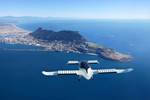EASA introduces Certification Readiness Level scale for aircraft technologies
Developed in partnership with Clean Aviation and the CONCERTO project, the CRL scale will provide a digital certification framework to shorten time to market for disruptive technologies with improved safety.
Source |
The (EASA, Cologne, Germany) has announced development of a new Certification Readiness Level (CRL) scale in partnership with the within the . The CRL scale is designed to assess the future certifiability of an innovative concept of operation, business model and/or product/system, while engaging progressively with aviation authorities to facilitate future shared oversight activities.
The CRL scale is offering a crucial complement to the traditional Technology Readiness Levels (TRLs). It includes nine main steps summarized as follows:
Source |
The CRL scale will be further detailed as part of future certification methods and means of compliance developed within the CONCERTO project. However, EASA encourages any applicant, technology developer and/or system supplier to familiarize themselves with this approach when measuring the growing level of maturity of product embedding innovative technology and/or concepts of operations ().
Source | CONCERTO project
is an EU-funded project under the Clean Aviation Joint Undertaking program. Its objective is to develop technical data which will constitute draft regulatory material for future breakthrough innovations. Its aims are twofold:
- Develop a comprehensive set of regulations on certification of aircraft, together with a preliminary description of methods of compliance (MoCs) applicable to the three “thrusts” of Clean Aviation:
– Hybrid electric regional aircraft
– Ultra-efficient short- and short-medium-range aircraft
– Disruptive technologies to enable hydrogen-powered aircraft. - Assess the feasibility of a digital certification framework to support collaboration and model-based certification.
Certification is expected to improve safety, while shortening time to bring new, safe products to market and into service and maintaining European leadership and competitiveness. The results are expected to be transposable and scalable to different product lines and aircraft segments such as general aviation, rotorcraft, business jets and commercial medium-long range, affecting the complete fleet.
The composition of the project’s consortium reflects a mix of aircraft manufacturers, engine manufacturers, equipment manufacturers, research centers, universities, SME and PLM experts. Playing a pivotal role between innovation and the development of safety, security or environmental protection standards, EASA experts are involved, acting together with industrial and research technical teams for the conception, endorsement of new solutions and enhancement of the international community acceptance.
Source | CONCERTO project,
Innovation Services
are offered by EASA to external stakeholders to support the introduction of new technologies or innovative solutions. Stakeholders interested in receiving technical advice services prior to or outside of an actual certification process conducted in accordance withCommission Regulation (EU) No 748/2012 and its Annex I (Part 21) can apply for Innovation Services.
Innovation services are one of the tools in portfolio, and contribute to building for industry a regulatory framework that allows — with legal certainty — to develop new ideas and to demonstrate that what industry develops is safe.
Related Content
-
The next-generation single-aisle: Implications for the composites industry
While the world continues to wait for new single-aisle program announcements from Airbus and Boeing, it’s clear composites will play a role in their fabrication. But in what ways, and what capacity?
-
Infinite Composites: Type V tanks for space, hydrogen, automotive and more
After a decade of proving its linerless, weight-saving composite tanks with NASA and more than 30 aerospace companies, this CryoSphere pioneer is scaling for growth in commercial space and sustainable transportation on Earth.
-
Plant tour: Collins Aerospace, Riverside, Calif., U.S. and Almere, Netherlands
Composite Tier 1’s long history, acquisition of stamped parts pioneer Dutch Thermoplastic Components, advances roadmap for growth in thermoplastic composite parts.






